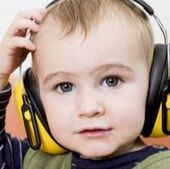 Many kids are hyper-sensitive to sound, ranging from extraneous background noise in the classroom to low frequency sounds like the vacuum cleaner or public toilet. This is known as auditory defensiveness, a condition in which a child's nervous system interprets noise as being too loud, too high pitched, or too difficult to tolerate. Auditory defensiveness results in the child lingering in defensive-mode, acquiring maladaptive coping strategies like tuning out, hyper-focusing on something else, attempting to escape the situation, or acting out. Here are some suggestions to help retrain your child's sound processing centers so that grocery shopping and fire drills are not so challenging.
1. Provide movement opportunities: Movement affects the structures of the inner ear, activating the vestibular system. Intense movement helps strengthen the vestibular system's sense of balance and orientation in space. As one system improves, so does the other. Time to go spin, jump, and swing on the playground! 2. Take new experiences slowly: Relief from sound sensitivity requires a gradual desensitization and not sudden full exposure. Start by observing something from afar, then taking a step closer on the next opportunity. Introduce your child to new places at quiet times, gradually increasing the amount of time spent there in future visits. 3. Prepare and problem solve: Let your child know you are doing something or going somewhere that may be noisy, providing them time to prepare themselves. Make a plan for what the child can do if it becomes too problematic. 4. Consult an OT about sound-based interventions: There are sound-based tools (like Therapeutic Listening) to help with auditory-perceptual or modulation challenges. The brain is plastic and can change. The auditory system, too, can be trained to integrate information better. 5. Use noise canceling headphones with caution: Noise canceling headphones can offer instant relief from noise. However, they quickly become a crutch to alleviate immediate symptoms and fail to treat underlying auditory processing problems. Deprivation of sound and conditioning the brain to not have to integrate it could even increase sensitivity and reactivity. Use sound muffling devices in moderation as a band aid in emergencies, but think twice about always using them. There are a number of environmental modifications you can make to help a child who is sensitive to sound. But, that path accommodates to the problem and prolongs it. As a neuroplasticity nerd, I advocate for the interventions that will help the brain learn to do a better job integrating sound. Although such solutions are larger and longer investments, they will ultimately yield your child's feeling of safety and enjoyment at your next trip to the coffee shop or Costco.
0 Comments
Your comment will be posted after it is approved.
Leave a Reply. |
meet the bloggerAusten is a pediatric occupational therapist with experience in schools, early intervention, and private clinic settings. She now runs her own private practice in Portland, OR specializing in movement based learning techniques. This blog's mission is to educate and empower parents and children by sharing insights into the complexities of learning and development. Categories
All
|
MINDFUL MOVEMENT THERAPIES
In-Home Pediatric Occupational Therapy in Portland, Oregon
phone503-720-4634
|
|
|


